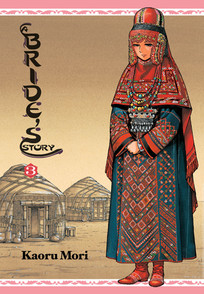Review
by Rebecca Silverman,A Bride's Story
GN 3
| Synopsis: |  |
||
Mr. Henry Smith has left Karluk and Amir's town to head for Ankara in Turkey. He's supposed to meet his guide in a nearby market town, but when the man is late, thieves steal his horse and belongings. This leads him to board with the beautiful widow Talas and her mother-in-law for a few days, which leads to a run-in with Talas' uncle. When the scheming man lands Mr. Smith in jail, things look decidedly grim... |
|||
| Review: | |||
With this volume of Kaoru Mori's beautifully illustrated tale, we leave behind Amir and Karluk, the couple who have been the focus of the previous two books...at least for a little while. The main character this time around is Mr. Henry Smith, the British linguist/anthropologist who has been staying with Karluk's family and is now ready to move on to study different languages and lifestyles. Karluk's family has arranged for a guide to meet Mr. Smith in a market town within four days' travel of their village, but when Mr. Smith arrives, the guide is nowhere to be found. He almost immediately falls victim to thieves, who steal not only his horse and donkey (with all of his possessions tied on), but also a horse belonging to Talas, a beautiful widow who lives outside of town with her mother-in-law. Together Mr. Smith and Talas reclaim their animals and Talas invites Mr. Smith to stay with her until his guide surfaces. As should be clear, Mori is setting up the story of a different bride, one who is a far cry from the sweetly independent Amir. Talas has been married multiple times, seemingly without protest. She now helps her aging mother-in-law around their farm, herding the sheep and selling them off when needed, a drastic measure akin to selling family heirlooms in a more sedentary society. She is the most covered woman we have seen thus far as well – Talas keeps her hair, neck, and shoulders covered by scarves and coats, and her dress, unlike Amir or Pariya's, barely shows her figure. In one scene, Talas, thinking that she is alone, takes off her scarves; her horror when Mr. Smith turns out to be near is palpable. This is, perhaps, an indication of geography; later on a man named “Ali” appears and mention is made of Persia (Iran). This volume is, in a lot of ways, about Mr. Smith learning the cultural differences between England (or anglicized India, as he mentions living there) and Asian countries. While we know that Amir had an arranged marriage and mention of the practice has been abundant thus far in the series, this is the first book to really look at the women as being property rather than people. Mr. Smith is, although he does not voice it, clearly taken aback by the way that Talas is treated by both her mother-in-law and her uncle in regards to marriage, and the bittersweet qualities of her story are evident, albeit understated in typical Mori fashion. His hesitance to accept this different world informs the actions of the volume, making this in some ways the most accessible to Western audiences. How would we react in a similar situation? It is an interesting question to ponder. Talas, as has been mentioned, is a very different character than Amir or Pariya, the two women we have thus far seen the most of. Pariya, who gets a short four-panel chapter all to herself in the middle of the book, is in direct contrast to Talas through her thoughts and actions, and Amir also shows a marked difference in attitude and behavior to the other woman, one that is made quite obvious in the latter half of the volume. Frank conversations between Karluk, Mr. Smith, and Ali about marriage also help to showcase the differing attitudes, continuing to make this an interesting series from an anthropological perspective as well. Also culturally fascinating are the differences between Amir's home and Talas'. Talas and her mother-in-law live in a semi-permanent yurt, plain on the outside and lavish on the inside. The food they eat is slightly different as well, and a marketplace chapter makes mention of some regional differences in dishes and eating practices. Clothing, particularly for the women, also shows variation – as has been said, Talas and her townswomen cover much more of their bodies, but the embroidery styles are also distinctly different than either Amir's tribeswomen or Pariya's townswomen. This level of detail continues to impress, from the length of time it takes Mr. Smith to sprout a beard to the subtleties of footwear, Kaoru Mori's pen is meticulous, even in the four-panel strips. Yen Press' edition continues to be exquisite with thick pages and a beautifully bound and slipcovered volume well worth the higher asking price than their average release. With a slightly more urgent storyline than the previous two volumes, a change in point of view character, and even more exquisite artwork, this installment of A Bride's Story continues to be an impressive addition to the catalog of English language manga. If you enjoy learning about Asian cultures outside of Japan, beautiful art, and don't mind a slower-paced read, you should really be reading this series. Despite its more melancholy tone, this volume continues to impress and leaves you eagerly awaiting Mr. Smith's – and Amir and Karluk's – next experiences. |
| Grade: | |||
|
Overall : A-
Story : B+
Art : A
+ More urgent storyline, fascinating cultural comparisons. Exquisitely detailed artwork and a beautiful edition. |
|||
| discuss this in the forum (7 posts) | | |||
| Production Info: | ||
|
Full encyclopedia details about Release information about |
||